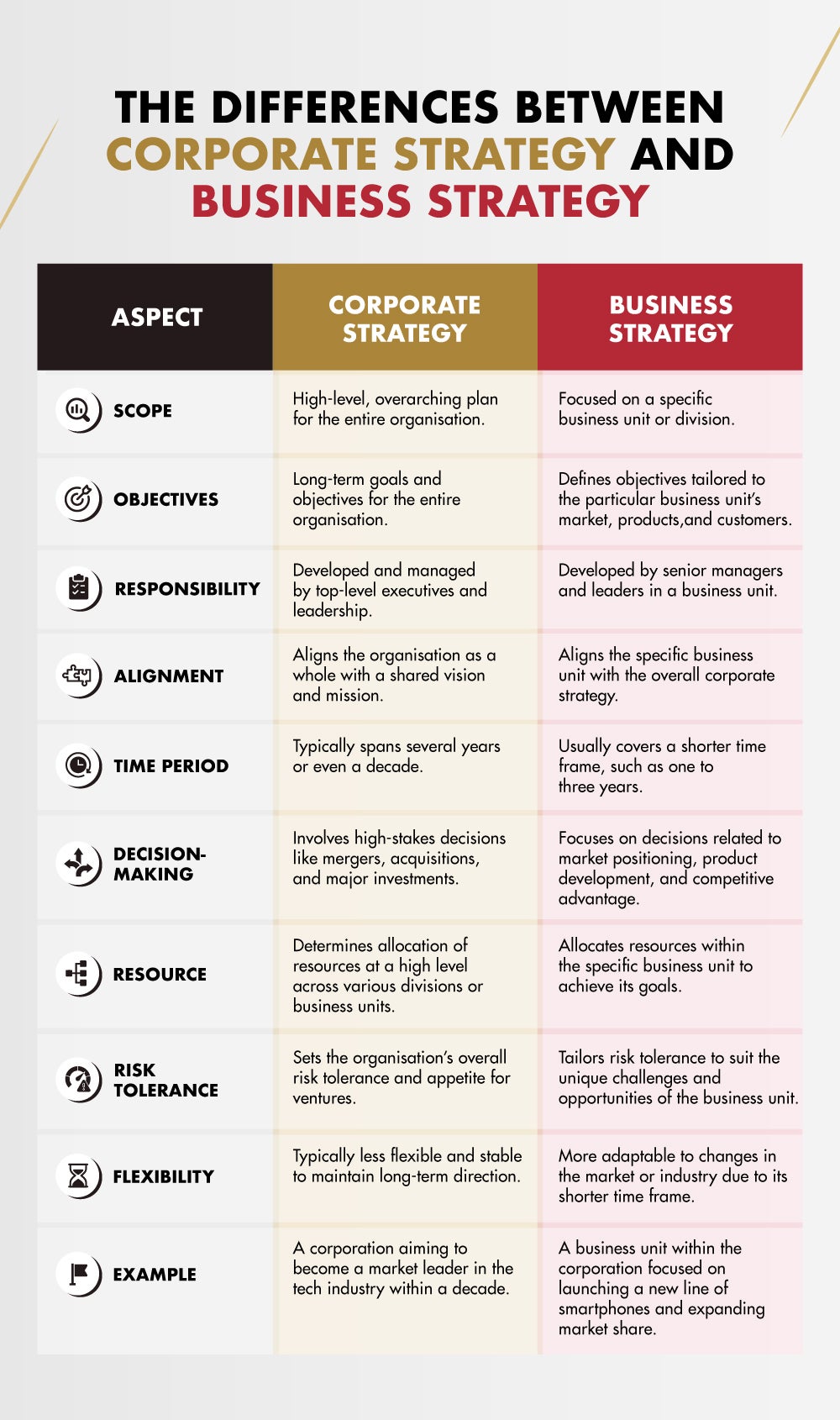
4 Must-Knows in Strategic Planning
Strategic planning is the secret sauce behind the triumph of many successful organisations — think of it as the compass that directs an organisation toward its goals, often done in anticipation of the forthcoming financial year. For professionals occupying managerial and leadership roles, understanding the nuances of strategic planning is crucial.
One example of strategic planning is corporate strategy, which is the overarching plan for an organisation's overall direction. Nevertheless, this is one out of many strategy planning levels.
So, let's explore 4 must-knows of strategic planning:
1. Levels of Strategy Planning
Strategic planning occurs at multiple levels within an organisation, where each serves a distinct purpose and contributes to the overall success. Understanding these levels is pivotal for crafting a coherent and effective strategy.
Corporate Strategy
Corporate strategy is the highest level of strategy planning, guiding the organisation's overarching direction and long-term objectives. It sets the stage for all other strategies within the organisation.
Imagine a multinational tech conglomerate with a vision to establish itself as a market leader in the tech industry within the next decade. Their corporate strategy could include their product portfolio, financial objectives, market expansion, and acquisition of innovative startups in the tech sector.
Business Strategy
Business strategy is more specific than corporate strategy, focusing on individual business units or divisions within the organisation. It aligns with the corporate strategy but provides a roadmap for how a particular business unit will achieve its objectives.
Continuing with our tech company example, if they have multiple divisions, each division might have its own business strategy tailored to its unique challenges and opportunities.
For instance, one of their divisions could be dedicated to mobile devices. Their business strategy might involve launching a new line of smartphones, increasing market share in specific regions, and forging strategic partnerships with mobile carriers.
Functional Strategy
Functional strategies are the most detailed and specific of all. They are concerned with the day-to-day operations and functions of different departments within a business unit.
For example, the marketing department may have a functional strategy outlining its plans to increase online visibility and engagement to support the broader business strategy of market leadership.
It could involve a digital-first approach, targeting younger demographics through social media and influencer partnerships. Meanwhile, in the Research and Development department, the functional strategy might prioritise innovation in battery technology to enhance smartphone battery life.
Operational Strategy
Operational strategy stands as the bridge between high-level corporate vision and the nitty-gritty of day-to-day execution.
Now, consider the manufacturing division within the mobile devices business unit of the same tech company example used above. Their operational strategy may involve streamlining production processes, optimising supply chain logistics, and managing the allocation of resources such as manpower and materials efficiently.
2. Difference Between Corporate Strategy and Business Strategy
It’s important to note that while corporate and business strategies are closely related, they are not interchangeable. Managers and leaders can plan these strategies simultaneously with harmonious collaboration.
In a nutshell, corporate strategy provides the overall vision, while business strategy looks into the specifics of how each business unit contributes to that vision.
To make this concept clearer, here's a simplified visual representation:

3. How to Build a Successful Strategy
Building a successful strategy requires careful planning and consideration of various components.
Identifying who is responsible for developing and executing the strategy is key. Make sure to assign roles and responsibilities to individuals or teams to ensure accountability and alignment.
Meanwhile, conducting an internal audit to assess your organisation's strengths, weaknesses, opportunities, and threats (SWOT analysis) is helpful. This helps in understanding your internal landscape and making informed decisions.
Additionally, here are some other common approaches:
-
Strategic goal setting: Define clear and achievable objectives aligned with your corporate vision.
-
Risk management: Identify potential obstacles and develop strategies to mitigate risks effectively.
-
Resource allocation: Allocate resources efficiently to support strategic initiatives.
-
Initiatives: Develop specific initiatives like partnerships, product development, or market expansion to drive growth.
-
Key questions: Continuously ask critical questions, such as "How much market share does our company aim to achieve this year?", "How are we serving the shareholders?", and "What strategies are we going to implement to address potential obstacles?", to maintain strategic clarity.
-
Cross-functional collaboration: Encourage collaboration among different departments and functions for a strategy that is well-integrated and supported across the organisation.
-
Values and culture: Ensure that your strategy is aligned with your organisation's core values and promotes a culture of innovation, adaptability, and continuous improvement.
-
Business model and portfolio: Review and adapt your business model and portfolio to align with your strategic objectives and market demands.
4. Common Strategic Planning Mistakes
Avoiding common strategic planning mistakes is just as crucial as following best practices. Here are some common pitfalls:
-
Frequent strategy changes: Evaluating your strategies regularly is essential, but changing them too often can lead to constant shifts in direction and wasted effort. A healthy balance between adaptation and stability is key.
-
Unrealistic resource allocation: Failure to allocate resources realistically can lead to overambitious plans or inadequate support for strategic initiatives. Ensure that your strategy aligns with the available resources.
-
Lack of clarity in objectives: Failing to define clear, specific, and measurable strategic objectives can lead to confusion and misalignment within the organisation.
-
Overlooking competitive analysis: Failing to understand and assess competitors can leave an organisation vulnerable to market shifts and new entrants.
-
Inadequate data: Relying on incomplete or outdated data can lead to flawed decision-making during the planning phase.
-
Overambitious goals: Setting unrealistic or overly ambitious goals can demotivate teams and lead to frustration.
Learn Strategy Planning Skills
We now know that strategic planning is a critical skill for managers and leaders aiming to steer their organisations towards success.
One tip we would like to give, is to consider pursuing an online MBA programme to enhance your strategic planning skills. Relevant modules such as Strategic Management, Corporate Finance, and Leadership & Organisational Behaviour can provide valuable insights and knowledge for individuals in mid to high-level management roles.
In fact, HELP University Online offers a Master of Business Administration that is tailored specifically for professionals. Interested? Schedule a FREE consultation with our dedicated Education Counsellors for more programme info.
